Why juggle resource scheduling and utilisation on your own when a ready-made Excel template can give you a head start?
In this guide, you’ll get access to our popular resource planning template, plus expert tips to help you get the most out of it. Whether you’re just getting started or looking to sharpen your planning skills, it’s a great first step.
But for growing firms juggling multiple people, projects, and client demands, Excel only gets you so far. That’s why we’ll also show you how smarter tools like Retain make resource planning faster, easier, and more effective, especially when skills, certifications, and utilisation targets matter.
What is a resource planning template?
A resource planning template helps you allocate the right people to the right projects at the right time. It gives you a structured way to track availability, assign work, and manage basic capacity.
Using a template like this in Excel can help you:
- See who’s available and when
- Allocate people to project tasks
- Monitor utilisation across your team
- Avoid overbooking and underuse
It’s a simple, practical tool for keeping projects on track and people properly assigned.
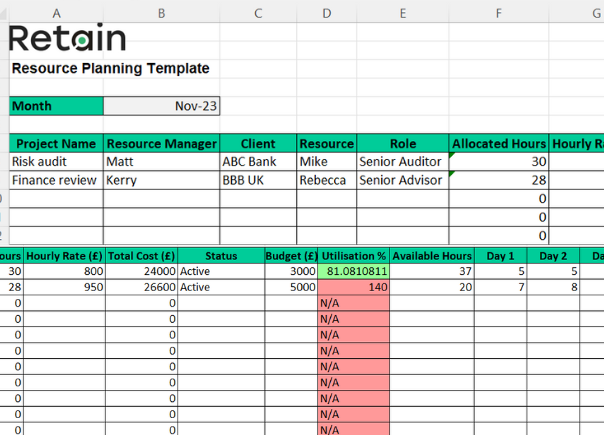
➡️Download your free Excel resource planning template here.
While Excel can give you a solid starting point, it’s not designed for complex, fast-moving teams. If you’re juggling multiple projects, certifications, or departments, it might be time to move beyond spreadsheets.
That’s where resource planning software like Retain comes in, built specifically to handle the realities of people-based planning. (More on this to come.)
So, if you are ready to ditch the spreadsheets, why not try Retain resource planning and management software? Take a look or talk to us.
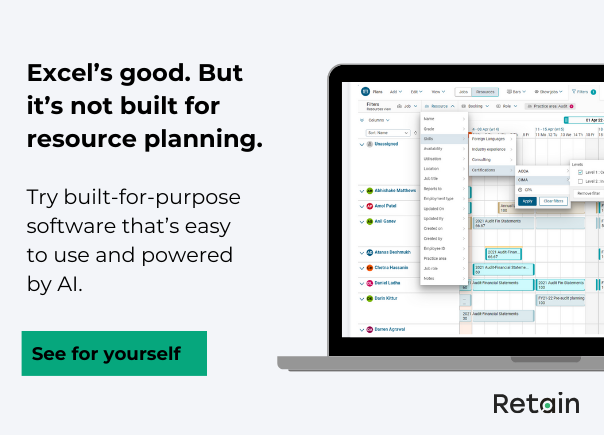
Now that you've secured your free template, it's time to amp up your resource planning skills. Here’s some tips on how to use it effectively.
Top 5 tips for maximising your resource planning in Excel
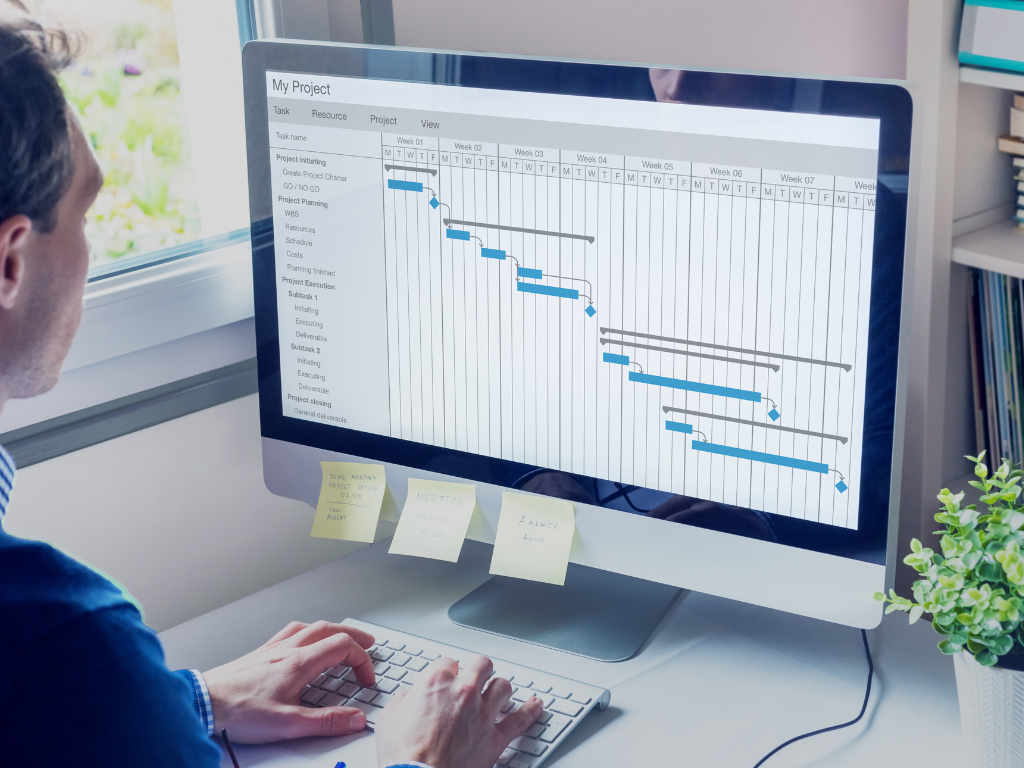
These top tips are your quick guide to becoming a resource planning whizz in Excel:
✅Master Excel shortcuts: Knowing your way around Excel can save you countless hours. For example, different shortcuts can be applied to a cell, such as editing a cell, aligning cell contents, adding an outline to all the selected cells, and many more.
✅Use conditional formatting: This allows you to set rules for cell formatting based on the data they contain, helping you spot issues at a glance. You’ll see we have added this to our template to flag when resources are under or over-utilised.
✅Implement data validation: Ensure accurate data entry by setting up drop-down lists or number ranges. This minimises the risk of errors that could affect your resource allocation.
✅Regularly update your template: Business needs change, and so should your resource planning template. Make it a habit to review and update it at least quarterly.
✅Run ‘what-if’ analyses: Before making major changes, use Excel’s What-If Analysis tool to predict different outcomes. This could help you avoid costly mistakes.
A solid Excel template can take you a long way. But if your projects are getting more complex or if you’re spending more time fixing spreadsheets than planning work, it might be time for a more flexible tool.
Next, we’ll look at where Excel starts to fall short and how Retain helps you go further.
Why isn’t resource planning in Excel enough? Let’s break it down:
Resource planning software vs Microsoft Excel: Which approach is best for you?

Excel is often the default planning tool for many organisations due to its accessibility and familiarity. But spreadsheets were designed for basic tables and calculations - not the complexities of resource management.
In short, Excel is great for basic tasks. But for complex resource planning? Not so much. Here's why:
- Limited visibility: Excel's siloed data complicates staffing optimisation.
- Manual overload: Spreadsheets are error-prone and high-maintenance.
- Inflexible planning: Excel's rigidity hampers custom projects and quick changes.
- Weak analytics: Excel requires manual analysis, making real-time insights a dream, not a reality.
Plus, relying on Excel can quickly become a bottleneck as your firm grows.
Let’s take a look at this a bit closer:
🔎 Limited visibility
Tracking allocation, capacity, and demand in siloed spreadsheets gives an incomplete picture. This makes it hard to optimise assignments and staffing. What may seem like smooth sailing in individual plans can mask conflicts.
🤯 Manual overload
Spreadsheets need constant manual adjustments, which can be a tedious process prone to errors. Plus, a minor tweak in one place can have downstream impacts. Not to mention that maintaining consistent up-to-date data across multiple files with many users is virtually impossible.
⬇️Inflexible planning
Excel lacks the flexibility to easily accommodate bespoke projects and priorities. Plus, modelling scenarios like reallocating resources or comparing alternatives is clunky at best. Responding to changes means reworking multiple plans. An absence of workflow rules also increases ambiguity for users.
❌Weak analytics
While Excel can generate reports, the number crunching is labour-intensive. Features like pivot tables help but don't remove the need for manual analysis. Lacking automation, it's hard to get real insights from your data. This prevents fact-based forecasting and optimisation.
In summary, spreadsheets clearly fall short of the needs of organisations that need to juggle many people, projects, and priorities.
Take Pitch Partners for example. Rapid growth created greater complexity in resource planning and job costing and spreadsheet-based processes limited visibility into resources and workloads. Plus, resource conflicts and bottlenecks decreased utilisation and profitability.
By moving beyond spreadsheets to advanced resource management, Pitcher Partner gained the visibility and flexibility needed to optimise staff utilisation. They saw business value instantly as they were able to plan (at a detailed staffing level) the year ahead.
Booking client projects for the next 12 months provided clear visibility of schedules and allowed them to strengthen their resource and engagement planning. The result was greater productivity, efficiency, and profitability firm-wide.
So is it time to consider software specifically designed for resource management? We'll dive into the benefits of doing so next.
Why specialised resource management software is more effective
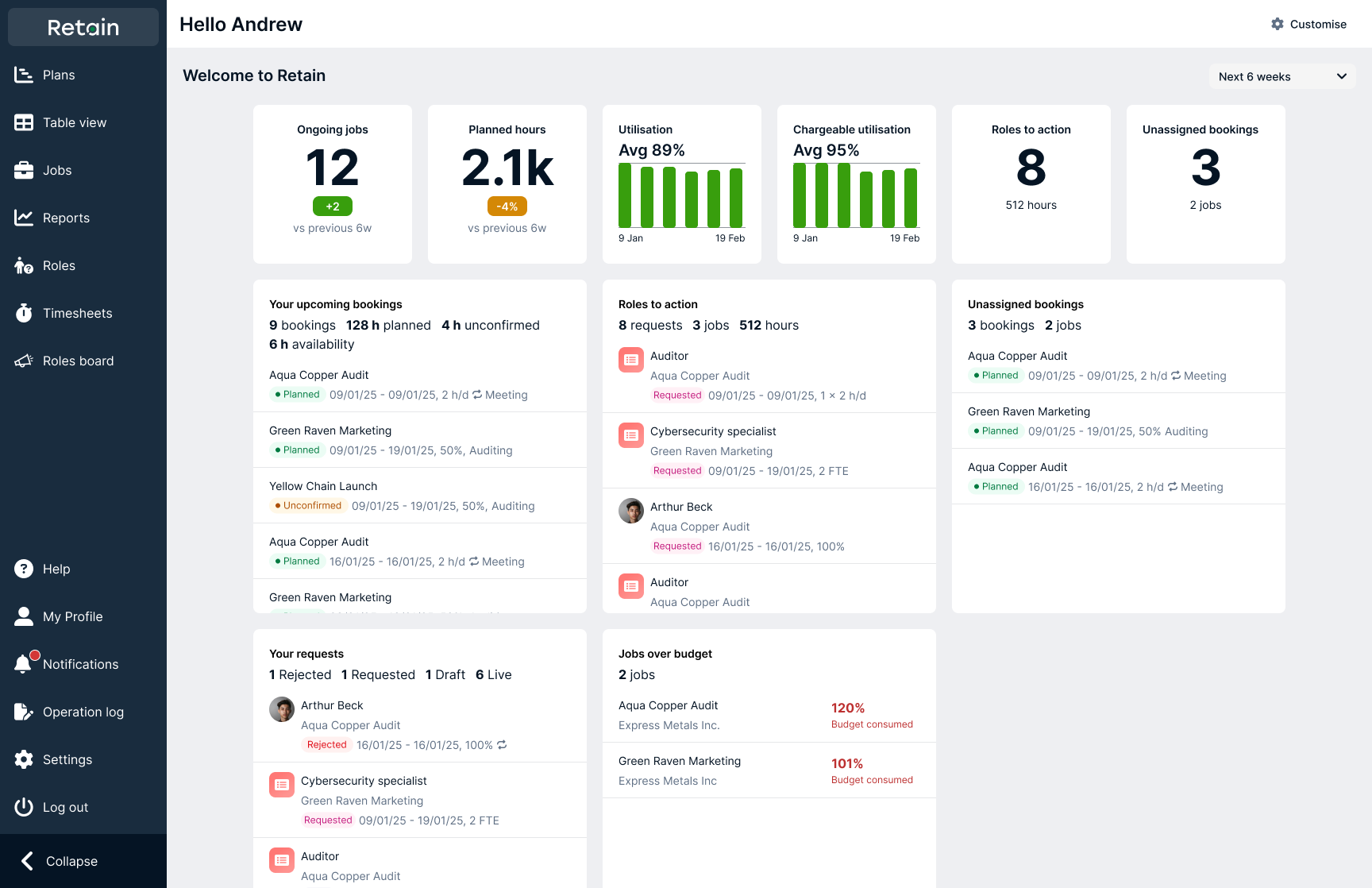
Resource management software, like Retain, is specifically designed to handle the unique challenges of people-powered services businesses. It provides a centralised system to maximise resource utilisation while balancing supply and demand.
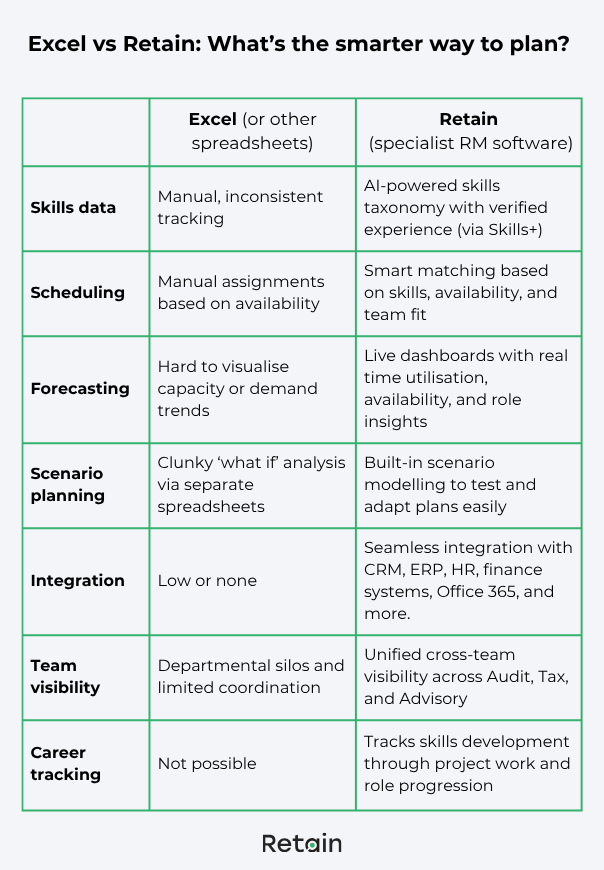
Let's look at some of the key capabilities:
1. Holistic visibility
All resource data is maintained in a single platform, giving real-time visibility into utilisation and availability. Drag-and-drop scheduling, allocation tracking, and colour-coding make analysis intuitive. This helps optimise assignments and staffing for the big picture.
2. Workflow automation
The manual work of updating spreadsheets is eliminated through automation. Resource management software centralises information and keeps it consistent system-wide. Plus, changes and notifications happen in real-time across integrated plans.
3. Flexible planning
Sophisticated tools support agile planning as projects evolve. Plus, scenario modelling enables "what-if" analysis to evaluate alternatives. Resources can be quickly reallocated as needs change. And workflow rules boost efficiency and consistency.
4. Powerful analytics
Embedded reporting and analytics provide data-driven insights. Dashboards track key metrics like utilisation rate, capacity vs demand, and project progress. And forecasting and modelling capabilities assist long-term planning.
To sum up, by removing the constraints of spreadsheets, resource management software streamlines coordination between projects, managers, and employees. The result: planning and decision-making also becomes far more precise.
If you're keen to learn more, you'll love our new ebook: Beyond Excel for resource planning.
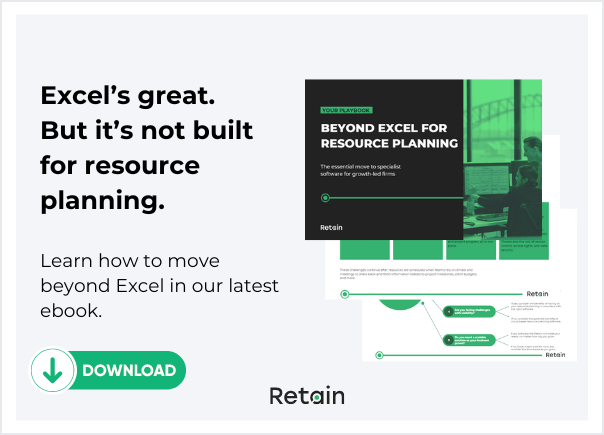
Retain: A better alternative to Excel resource planning templates
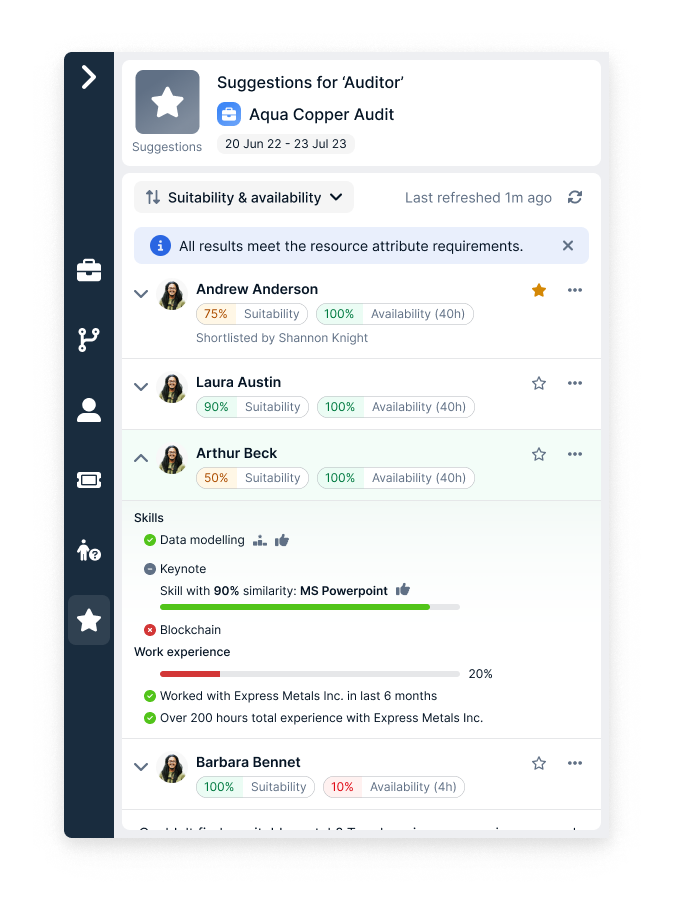
Retain is a unified resource management platform that connects skills, availability, performance, and planning in one place. Here's what that looks like in action:
🎯 Schedule based on real skills, not guesswork
With Retain’s Skills+ taxonomy, powered by Lightcast, you can tag, search, and filter by over 30,000 standardised skills, including experience level and recency of use.
🧠 Use AI to match people to projects
Retain goes beyond availability. Its AI-powered matching suggests the best-fit people for each role based on skills, team fit, preferences, and past project performance.
📊 Track utilisation, billable hours & budget in real time
Custom dashboards let you see who’s overbooked, underutilised, or nearing budget, all without touching a spreadsheet.
🔁 Stress-test your plan with scenario modelling
Easily run “what-if” scenarios to test staffing changes, project shifts, or resource constraints, then act fast with drag-and-drop reallocation.
🧩 Integrate everything
Retain works seamlessly with tools you already use — from Microsoft Dynamics and IRIS, to SAP, Office 365, Salesforce, and more — so your planning connects with your CRM, finance, and HR systems.
👥 Understand how teams work together
Retain even includes behavioural profiling to support stronger, better-balanced teams, by factoring in working styles and collaboration preferences.
Boost resource management with the right tools
Excel templates are a start, but they lack the firepower for today’s resource management.
Specialised software like Retain delivers unmatched capabilities: AI-powered allocation, automatic utilisation calculations, and easy integrations.
Specialist resource management software like Retain has capabilities which Excel just can’t compete with. With features that take resource planning to the next level:
- AI-powered resource allocation and skills matching
- Automatic resource utilisation calculations
- Bespoke reporting and custom data fields
- Easy integrations with existing tools
With Retain as your planning partner, you’ll never leave profit on the table. Upgrade to Retain and maximise your profits.
Take a look at our solution or book a demo to see for yourself.
Looking for more?
- Beyond spreadsheets: How mature is your resource planning approach?
- How to build a business case for resource planning software
- How to choose the best resource management software
Or if you still have questions, you might like our FAQs, below:
What is a good Excel template for resource planning?
A good resource planning Excel template should include columns for project name, resource name, availability, allocation %, task details, and utilisation calculations. It should also use conditional formatting to highlight overbooked or underused team members. You can download our free Excel resource planning template.
When should you use Excel for resource planning?
Excel is best for small teams, short-term projects, or early-stage planning. It’s a flexible, low-cost option for basic resourcing, especially when you only need to track availability and tasks across a handful of people.
What are the drawbacks of using Excel for resource planning?
While Excel is familiar and easy to access, it falls short when managing complex projects or large teams. Common issues include:
- Siloed and inconsistent data
- Manual updates and risk of errors
- No integration with HR or finance tools
- Limited forecasting or scenario planning
- Difficult to scale across departments
When should you use specialised software for resource planning?
If you’re managing multiple projects, tracking skills or certifications, forecasting demand, or reporting on utilisation, it’s time to consider purpose-built software. Platforms like Retain help you match the right people to the right work, visualise availability in real time, and plan more strategically.
How do resource management tools differ from project management software?
Project management tools (like Asana or Trello) focus on task execution and timelines. Resource management tools focus on people — helping you plan who works on what, when, and why. They provide visibility into capacity, utilisation, skills, and team planning.
What features should you look for in resource planning software?
The key resource planning features to look for, include:
- A structured skills database
- AI-powered matching and scheduling
- Real-time utilisation dashboards
- Scenario planning tools
- Seamless integrations (CRM, HR, finance)
- Support for development and training insights
Can resource planning software help with billable hours and profitability?
Yes. Tools like Retain track time, budget, and utilisation in real time, helping you allocate resources more profitably and spot bottlenecks early.
Want to see what smarter resource planning looks like? Book a demo of Retain and we’ll walk you through it.


